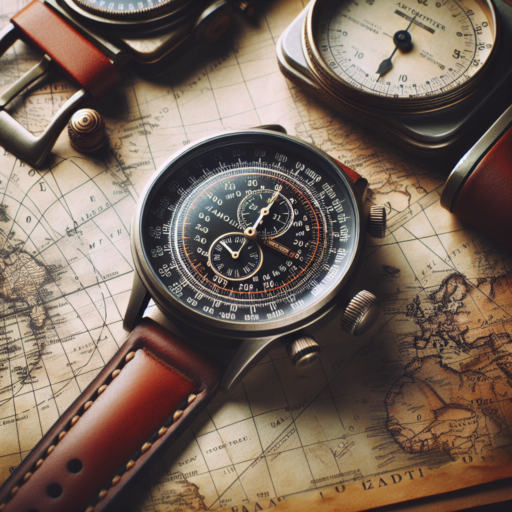What Is an Analog Altimeter Watch?
An analog altimeter watch is a specialized wristwatch designed not only to tell time but also to measure the wearer’s altitude above a fixed level. This fascinating piece of technology combines traditional watch mechanics with an altimeter function, making it an essential tool for hikers, mountaineers, and aviation enthusiasts. Unlike digital models, the altimeter function in these watches is indicated through a manual dial and hands, providing a unique blend of functionality and classic style.
At its core, the analog altimeter operates using a barometric pressure sensor. Changes in atmospheric pressure are used to estimate altitude, with higher altitudes corresponding to lower pressure levels. This analog process involves intricate mechanical design, where sensitive components react to pressure changes, translating them into altitude readings displayed on the watch face. Such watches often feature a scale or sub-dial specifically dedicated to showing altitude, making it easy for the user to read their elevation at a glance.
Many analog altimeter watches come equipped with additional functions that cater to outdoor and aviation activities. These may include a compass, thermometer, and weather trend indicators, enhancing the device’s utility beyond mere timekeeping and altitude measurement. The appeal of these watches lies not only in their practicality but also in their aesthetics; they embody a sense of adventure and exploration, rendered in styles that reflect classic watchmaking craftsmanship. Wearers often choose these watches for their functionality, sure, but also for the statement they make about a lifestyle that values precision, durability, and a connection with the natural world.
Top Benefits of Using an Analog Altimeter Watch for Outdoor Adventures
Engaging in outdoor activities, especially those that involve exploring the vastness of nature, calls for reliable equipment. Among these crucial gadgets is the analog altimeter watch, a tool that has stood the test of time, providing adventurers with valuable information about their elevation. This timeless piece of gear offers several benefits that enhance the outdoor experience.
Accurate Elevation Readings
The primary function of an analog altimeter watch is to provide precise elevation data. This is critical for hikers, mountaineers, and anyone engaged in high-altitude activities. Being aware of your altitude is not only essential for navigation but also for safety purposes. It can help adventurers make informed decisions about their route and manage their pace, especially in challenging terrains. The beauty of an analog altimeter watch lies in its reliability; it doesn’t rely on satellite signals, making it a trustworthy companion in remote areas where digital devices might fail.
Durability and Longevity
Analog altimeter watches are renowned for their ruggedness. Designed to withstand harsh outdoor conditions, these watches are typically constructed with robust materials like stainless steel and scratch-resistant glass. This makes them not just survival tools but also long-term investments for outdoor enthusiasts. Unlike digital gadgets, which may require frequent updates or suffer from battery issues, analog altimeter watches maintain their functionality over time, ensuring that adventurers have access to essential information whenever they need it, without the fear of technological hiccups.
Simple Yet Effective
In an era where technology can sometimes become overwhelming, the simplicity of an analog altimeter watch is its charm. They offer a straightforward and user-friendly interface, making it easy to read elevation data at a glance without navigating through complex menus or dealing with the challenges of a touch screen when wearing gloves or in wet conditions. This ease of use is particularly beneficial when focusing on the adventure at hand is more important than fiddling with gadgets.
How Does an Analog Altimeter Watch Work?
An analog altimeter watch, a quintessential tool for outdoor adventurers and pilots, operates on a compelling mechanism that has piqued the interest of many. This intricate device combines the traditional watch functions with the ability to measure the wearer’s elevation above sea level. But how exactly does this technologically advanced accessory function? Understanding the workings of an analog altimeter watch begins by delving into the core principle it relies on – atmospheric pressure.
At the heart of an analog altimeter watch lies a sensitive component known as an aneroid barometer. This component is pivotal in translating atmospheric pressure into altitude readings. As one ascends or descends, the atmospheric pressure changes – this pressure is inversely proportional to altitude. The aneroid barometer in the watch senses these pressure changes and moves a set of gears connected to the altimeter hands. These hands, marked against a calibrated scale, display the current altitude.
It’s crucial to note the relationship between atmospheric pressure and weather changes, which introduces a layer of complexity to the altimeter watch’s accuracy. To ensure precision, many analog altimeter watches come equipped with adjustment settings that allow users to calibrate the altimeter based on known elevations or current sea-level pressure readings. This feature underscores the importance of understanding local conditions for accurate altitude measurement.
The Best Analog Altimeter Watches of 2023: Models and Features Compared
In the quest for the perfect blend of traditional watch aesthetics with modern functionality, 2023 has seen a surge in the popularity of analog altimeter watches. These timepieces not only serve the purpose of telling time but also offer the crucial functionality of altitude measurement, making them a top choice for outdoor enthusiasts, hikers, and climbers. The evolution in their design makes them not only practical but also stylish accessories for everyday wear.
Among the standout models this year, certain features have become pivotal in defining what makes an altimeter watch truly exceptional. Key components to look for include accuracy in altitude measurement, durability in design, and additional functionalities such as barometric pressure indicators and temperature readings. Brands have also focused on ensuring these watches remain lightweight and comfortable, without sacrificing their ruggedness or water resistance.
Noteworthy Models to Consider
- Model A: Known for its precision and ease of use, this watch boasts a sleek design, making it suitable for both outdoor adventures and casual settings. Its altimeter function is complemented by a barometric pressure indicator and a digital compass.
- Model B: This rugged timepiece is designed to withstand extreme conditions, featuring a robust casing and enhanced water resistance. It offers a detailed altimeter alongside temperature measurement capabilities, catering to the needs of serious mountaineers.
- Model C: With a focus on minimalism, this model appeals to those who appreciate simplicity without compromising functionality. It provides accurate altitude readings and is incredibly user-friendly, making it ideal for beginners and casual hikers.
The integration of altimeter functions within a traditional analog watch display has not only expanded the usability of these timepieces but also introduced a variety of models catering to different preferences and needs. As manufacturers continue to innovate, the selection of analog altimeter watches in 2023 offers something for every adventurer out there.
Setting Up Your Analog Altimeter Watch for Accurate Readings
Ensuring that your analog altimeter watch provides accurate readings is crucial for anyone relying on this tool for navigation, hiking, or other outdoor activities. The calibration process might seem daunting at first, but with the right guidance, you can set up your watch for precision and reliability. This article will walk you through the necessary steps to achieve optimal performance from your altimeter watch.
Understanding Your Watch’s Altimeter Function
Before diving into the setup process, it’s essential to understand how your analog altimeter watch works. These watches use atmospheric pressure to determine your altitude, meaning that any changes in weather can affect their accuracy. Knowing this, it’s crucial to regularly calibrate your watch, especially before embarking on any activity where precision is vital. Recognizing the signs of needing recalibration—such as significant altitude discrepancies—is key to maintaining your watch’s performance.
Step-by-Step Calibration Process
- Find a Reference Point: Start by determining a known altitude that you can use as a reference for calibration. This could be a specific location marked on a map or a known altitude reading from a reliable source.
- Adjust the Settings: Once you have your reference point, adjust the settings on your analog altimeter watch to match this known altitude. This usually involves turning a dial or pressing a combination of buttons depending on your specific watch model.
- Check for Accuracy: After setting your watch, compare its reading with the known altitude of several different locations to ensure its accuracy. If discrepancies continue, repeat the calibration process until you achieve consistent results.
By regularly calibrating your analog altimeter watch and understanding its functionality, you can ensure more reliable and accurate altitude readings. This not only enhances your outdoor experience but also contributes to your safety and navigation efficiency.
Maintaining Your Analog Altimeter Watch: Tips and Tricks
Keeping your analog altimeter watch in top condition requires a mix of regular maintenance, proper usage, and a bit of attention to detail. These timeless pieces, beloved by adventurers and professionals alike, combine classic aesthetics with functional precision. However, without the right care, their intricate mechanics can degrade over time. Here, we’ll delve into some essential tips and tricks to ensure your analog altimeter watch remains a reliable companion on all your adventures.
Regular Cleaning is Key
First and foremost, regular cleaning is vital. Dust, sweat, and grime can accumulate, particularly in the crevices of the watch, leading to potential damage to the altimeter’s accuracy. Use a soft, dry cloth to gently wipe the surface of your watch. For tougher grime, a damp cloth with a bit of mild soap can be used, but ensure no water seeps into the inner mechanics. Always remove the watch from your wrist while cleaning to avoid damaging the band.
Periodic Calibration for Accuracy
To maintain the precision of your analog altimeter watch, periodic calibration is essential. Changes in atmospheric pressure can affect readings, making it necessary to recalibrate your watch, especially if you’re planning to use it in drastically different elevations within a short period. Refer to your manufacturer’s guide on how to correctly perform calibration, or consider consulting a professional to ensure optimal performance.
Avoid Extreme Conditions
While analog altimeter watches are built for adventure, exposing them to extreme conditions can shorten their lifespan. Sudden temperature changes, high humidity, and direct sunlight can adversely affect the internal components. When not in use, store your watch in a cool, dry place, and avoid leaving it in places like the dashboard of your car or near windows where it can be exposed to such extremes. Additionally, be mindful of altitude limits as specified by the manufacturer to prevent overstressing the mechanism.
No se han encontrado productos.
Analog vs. Digital Altimeter Watches: Which Is Better for You?
Choosing between an analog and digital altimeter watch can significantly impact your outdoor adventures, but the best choice depends on your personal preferences and needs. Analog altimeter watches are prized for their classic aesthetic and mechanical precision. They offer a tactile and direct interaction with the device, which many enthusiasts prefer. On the other hand, digital altimeter watches provide a plethora of features, including barometric pressure readings, temperature data, and even GPS functionality, all accessible with just a few button presses.
Understanding Analog Altimeter Watches
Analog altimeter watches are renowned for their durability and long-lasting performance. Traditionalists favor these watches for their skillful blend of form and function. Operating on a purely mechanical basis, they can be more intuitive for reading altitudes quickly. However, they often lack the additional sensors and data tracking capabilities that come standard with digital models.
Benefits of Digital Altimeter Watches
On the flip side, digital altimeter watches cater to the modern explorer with their multifunctionality. They shine in providing real-time data, essential for making informed decisions quickly. Features like storm alerts, automatic calibration, and detailed logs of your climbs make digital altimeter watches indispensable tools for serious adventurers. Their ability to sync with smartphones and other devices for data analysis and sharing adds another layer of utility.
How to Calibrate Your Analog Altimeter Watch for Precision
Calibrating your analog altimeter watch is crucial for ensuring its accuracy, especially if you rely on it for activities like hiking, skydiving, or any outdoor adventure where altitude measurements are important. The process of calibration aligns the watch’s readings with a known altitude, ensuring that the measurements it provides are precise. By regularly calibrating your altimeter watch, you can trust the data it presents, enhancing your outdoor experience and safety.
Begin by locating a reference point where you know the exact altitude. This could be a spot marked on a topographical map or a location’s elevation listed online. Once you’ve identified your reference point, you can proceed to adjust your analog altimeter watch. Remember, the key to accuracy is using a reliable reference altitude. Without it, your calibration efforts won’t yield the precision you’re aiming for.
To adjust the altimeter, locate the calibration screw or knob on your watch. This is typically found along the side or back. Using a small screwdriver or the tool provided with your watch, carefully turn the knob until the watch’s altitude reading matches your reference point’s altitude. It’s a delicate process, but vital for ensuring your watch’s precision. After adjusting, verify the calibration by comparing the watch’s altitude reading with another known altitude location.
Regular calibration is recommended, especially after significant changes in geographic location or after exposure to extreme weather conditions. These variables can affect the watch’s accuracy, making recalibration necessary to maintain its precision. Keep in mind that changes in weather, especially barometric pressure, can also impact altitude readings, so consider this factor when planning your calibration schedule.
Expert Tips on Choosing the Right Analog Altimeter Watch for Your Needs
When it comes to selecting the perfect analog altimeter watch, understanding your specific needs and how these watches function is paramount. An analog altimeter watch is not just a tool for measuring elevation; it’s a companion for your adventures, a piece of precision equipment that blends functionality with style.
Consider Your Lifestyle and Activities
One of the first steps in choosing the right analog altimeter watch is to consider your lifestyle and the activities you plan to undertake. Whether you are an avid hiker, a mountaineer, or someone who enjoys outdoor sports, your watch should align with your activities. For instance, durability and water resistance are crucial for extreme outdoor activities, while accuracy and ease of reading are essential for technical climbs.
Analyze Features and Specifications
Delving into the features and specifications is another vital step. Look for an analog altimeter watch that offers precision in altitude measurement and includes features like a barometer for weather prediction and a compass for navigation. The accuracy of these features can greatly enhance your outdoor experience, providing you with valuable information at a glance. Additionally, consider the watch’s battery life and whether it has a manual or automatic calibration for the altimeter, as these aspects can impact its convenience and reliability.
Common Misconceptions About Analog Altimeter Watches Debunked
When it comes to analog altimeter watches, several myths have clouded consumers’ judgments, preventing many from understanding the true capabilities and limitations of these precision instruments. One of the most prevailing misconceptions is that analog altimeter watches are significantly less accurate than their digital counterparts. However, the truth is that the accuracy of an altimeter, whether analog or digital, largely depends on the calibration and the technology it uses to measure altitude changes. Modern analog altimeter watches incorporate sophisticated mechanisms and barometric sensors, allowing them to offer competitional accuracy to digital models.
Another common myth is that analog altimeter watches can’t withstand harsh environments and are not as durable as digital watches. This misconception overlooks the fact that many high-quality analog altimeter watches are designed with ruggedness in mind, featuring robust materials like stainless steel and sapphire crystal. These watches are crafted to endure extreme conditions, including significant changes in pressure and temperature, making them a reliable companion for adventurers and outdoor enthusiasts.
Lastly, the belief that analog altimeter watches are cumbersome to use due to their mechanical complexity is a misunderstanding. Many models come equipped with intuitive interfaces and easy-to-read dials, ensuring that users can quickly and accurately gauge altitude readings without fuss. Calibration processes have also been simplified over the years, rendering the argument of complexity less relevant. True watch aficionados appreciate the craftsmanship and detailed engineering that go into the production of analog altimeter watches, seeing them not only as practical tools but as pieces of art.




